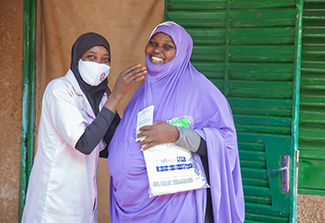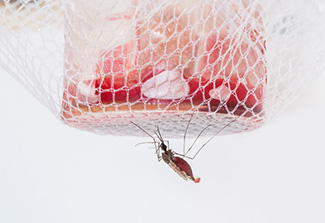Tracking antimalarial drug resistance in Uganda
May / June 2022 | Volume 21 Number 3
 Photo courtesy of Impact MalariaThe largest burden of malaria worldwide is among children under 5 and pregnant women.
Photo courtesy of Impact MalariaThe largest burden of malaria worldwide is among children under 5 and pregnant women.
Malaria, a life-threatening disease that causes fever, headaches, and chills, is an everyday reality for many people: 241 million cases were tallied in 2020. Across Africa, the parasitic infection transmitted by mosquitoes is commonly treated with artemether, a derivative of the drug artemisinin, combined with a second antiparasitic, often lumefantrine. The regimen works by delivering a one-two punch, explained Dr. Melissa Conrad, an assistant professor at University of California, San Francisco. Artemisinin kills parasites quickly but it has a short half-life, disappearing from the blood stream within two days. Here the second drug takes up the fight.
“Recent research has shown
ex vivo and clinical evidence of emerging artemisinin resistance in Uganda,” said Conrad.
Ex vivo refers to laboratory studies performed on tissues or cells removed from a living organism.
The risk when one drug in a combination regimen begins to fail is it leaves more parasites to be killed by the second drug, thereby increasing the probability that the second drug becomes ineffective. “From
ex vivo drug sensitivity studies, we see some evidence of what we think is decreased sensitivity to lumefantrine in the same region of Uganda where we are seeing artemisinin resistance,” said Conrad. She added that clinical therapeutic efficacy studies, in which tests are done on human volunteers, are needed to verify that the second drug has also begun to fail. The U.S. President’s Malaria Initiative and the Uganda Ministry of Health are planning to conduct these higher cost studies soon. Urgency is needed; malaria claims more than 400,000 lives annually, most of them children younger than 5.
 Photo courtesy of Dr. Melissa ConradDr. Melissa Conrad's team feeds malaria-infected blood from Ugandan patients to mosquitoes to measure factors that impact disease transmission.
Photo courtesy of Dr. Melissa ConradDr. Melissa Conrad's team feeds malaria-infected blood from Ugandan patients to mosquitoes to measure factors that impact disease transmission.
Conrad’s
Fogarty-supported research includes
ex vivo experiments where she feeds malaria-infected blood from Ugandan patients to mosquitoes to measure a variety of parasite and mosquito factors that impact disease transmission. Her molecular AMR surveillance work also addresses such questions as: Where is decreased drug sensitivity taking place? Why? In north Uganda, in a high malaria transmission area, and in the southwest near Rwanda, mutations have cropped up, said Conrad. Possible reasons for emerging resistance in these regions include different treatment behaviors and low-quality drugs. “One of the best things we can do right now is do a good job with our surveillance, so we detect worrisome trends before they really translate into morbidity and mortality,” she said.
Reasons for hope include new drugs in the pipeline, though none are “as close to being readily available as we wish,” said Conrad. “We can work with the existing drugs to get people treated but it's going to take a lot of really good clinical work.” This means using appropriate drugs and educating patients to use them correctly. Given evidence that there is not yet full-scale resistance to artemisinin— “it's more of a tolerance” —prolonged treatment with existing drugs may help overcome the current problem. “Various groups are also studying triple combination therapies, where the parasites have to cope with all these different drugs simultaneously, which is way harder to do.”
There are tools, then, for avoiding a “true emergency,” said Conrad. “I’m realizing that these problems are both global and local and need to be addressed in both ways.” Undoubtedly, Ugandans have benefited from all the work that has been done in Southeast Asia where artemisinin resistance first emerged. Yet contextual challenges are real and require local surveillance and local relationships between clinicians, policymakers and researchers to find solutions. “Malaria is very different in different parts of the world. It would be wise for us to benefit from what we've learned elsewhere, but also recognize that we need to know what's happening locally.”
More Information
Updated June 15, 2022
To view Adobe PDF files,
download current, free accessible plug-ins from Adobe's website.
Related Fogarty Programs
Related World Regions / Countries
Related Global Health Research Topics